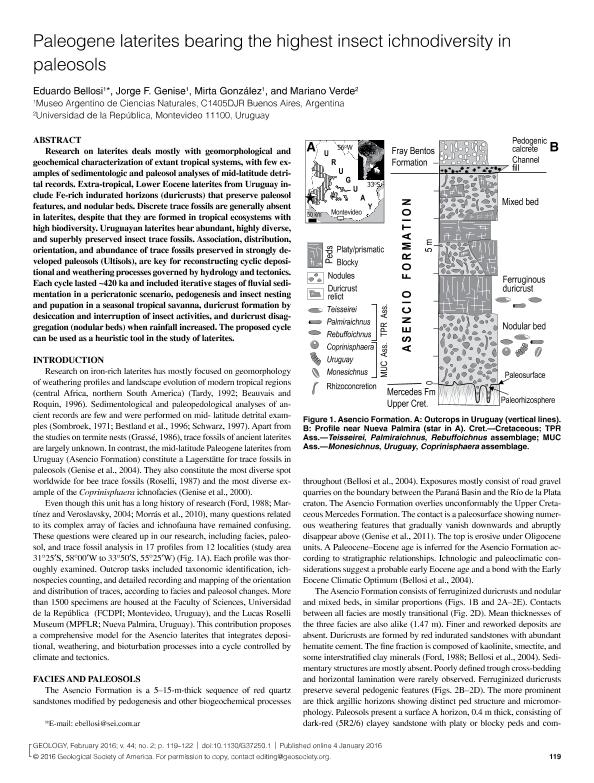Mostrar el registro sencillo del ítem
dc.contributor.author
Bellosi, Eduardo Sergio

dc.contributor.author
Genise, Jorge Fernando

dc.contributor.author
Gonzalez, Mirta Gladys

dc.contributor.author
Verde, Mariano

dc.date.available
2018-06-19T16:25:08Z
dc.date.issued
2016-01
dc.identifier.citation
Bellosi, Eduardo Sergio; Genise, Jorge Fernando; Gonzalez, Mirta Gladys; Verde, Mariano; Paleogene laterites bearing the highest insect ichnodiversity in paleosols; Geological Society of America; Geology; 44; 2; 1-2016; 119-122
dc.identifier.issn
0091-7613
dc.identifier.uri
http://hdl.handle.net/11336/49284
dc.description.abstract
Research on laterites deals mostly with geomorphological and geochemical characterization of extant tropical systems, with few examples of sedimentologic and paleosol analyses of mid-latitude detrital records. Extra-tropical, Lower Eocene laterites from Uruguay include Fe-rich indurated horizons (duricrusts) that preserve paleosol features, and nodular beds. Discrete trace fossils are generally absent in laterites, despite that they are formed in tropical ecosystems with high biodiversity. Uruguayan laterites bear abundant, highly diverse, and superbly preserved insect trace fossils. Association, distribution, orientation, and abundance of trace fossils preserved in strongly developed paleosols (Ultisols), are key for reconstructing cyclic depositional and weathering processes governed by hydrology and tectonics. Each cycle lasted ~420 ka and included iterative stages of fluvial sedimentation in a pericratonic scenario, pedogenesis and insect nesting and pupation in a seasonal tropical savanna, duricrust formation by desiccation and interruption of insect activities, and duricrust disaggregation (nodular beds) when rainfall increased. The proposed cycle can be used as a heuristic tool in the study of laterites.
dc.format
application/pdf
dc.language.iso
eng
dc.publisher
Geological Society of America

dc.rights
info:eu-repo/semantics/openAccess
dc.rights.uri
https://creativecommons.org/licenses/by-nc-sa/2.5/ar/
dc.subject
Paleogene
dc.subject
Laterites
dc.subject
Ichnodiversity
dc.subject
Paleosoils
dc.subject.classification
Meteorología y Ciencias Atmosféricas

dc.subject.classification
Ciencias de la Tierra y relacionadas con el Medio Ambiente

dc.subject.classification
CIENCIAS NATURALES Y EXACTAS

dc.title
Paleogene laterites bearing the highest insect ichnodiversity in paleosols
dc.type
info:eu-repo/semantics/article
dc.type
info:ar-repo/semantics/artículo
dc.type
info:eu-repo/semantics/publishedVersion
dc.date.updated
2018-05-24T14:30:58Z
dc.identifier.eissn
1943-2682
dc.journal.volume
44
dc.journal.number
2
dc.journal.pagination
119-122
dc.journal.pais
Estados Unidos

dc.description.fil
Fil: Bellosi, Eduardo Sergio. Consejo Nacional de Investigaciones Científicas y Técnicas. Oficina de Coordinación Administrativa Parque Centenario. Museo Argentino de Ciencias Naturales ; Argentina
dc.description.fil
Fil: Genise, Jorge Fernando. Consejo Nacional de Investigaciones Científicas y Técnicas. Oficina de Coordinación Administrativa Parque Centenario. Museo Argentino de Ciencias Naturales ; Argentina
dc.description.fil
Fil: Gonzalez, Mirta Gladys. Consejo Nacional de Investigaciones Científicas y Técnicas. Oficina de Coordinación Administrativa Parque Centenario. Museo Argentino de Ciencias Naturales ; Argentina
dc.description.fil
Fil: Verde, Mariano. Universidad de la República; Uruguay
dc.journal.title
Geology

dc.relation.alternativeid
info:eu-repo/semantics/altIdentifier/url/https://pubs.geoscienceworld.org/gsa/geology/article-abstract/44/2/119/132017/paleogene-laterites-bearing-the-highest-insect?redirectedFrom=fulltext
dc.relation.alternativeid
info:eu-repo/semantics/altIdentifier/doi/https://dx.doi.org/10.1130/G37250.1
Archivos asociados
